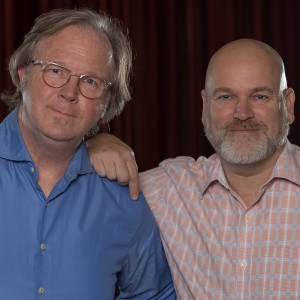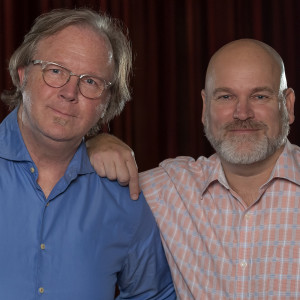
Stories, science and secrets from the world’s brightest thought-leaders. Behavioral Grooves is the podcast that satisfies your curiosity of why we do what we do. Explanations of human behavior that will improve your relationships, your wellbeing, and your organization by helping you find your groove.
Episodes

Sunday Jul 26, 2020
Steve Wendel, PhD: Designing for Behavior Change
Sunday Jul 26, 2020
Sunday Jul 26, 2020
Stephen Wendel, PhD is an applied behavioral scientist who studies how digital products can help people take action more effectively. He currently serves as Head of Behavioral Science at Morningstar, leading a team of behavioral scientists and practitioners who conduct original research on saving and investment behavior.
Steve has authored “Designing for Behavior Change,” “Improving Employee Benefits,” and “Spiritual Design.” He is also a co-founder of the non-profit Action Design Network that focuses on educating the public on how to apply behavioral research to product development with monthly events in fifteen cities.
In our conversation, we talked about epistemic humility, which is a cool concept that was new to both Kurt and Tim. We also discussed a few of our favorite topics including the role of behavioral science in the corporate world, the ethical application of behavioral science, and how important context is to … well, everything.
We hope you enjoy our conversation with Steve and encourage you to take a moment to leave a review or check out our Patreon page at www.patreon.com/behavioralgrooves.
© 2020 Behavioral Grooves
Links
Stephen Wendell, PhD: https://www.linkedin.com/in/sawendel/
BehavioralTechnology.co: https://www.behavioraltechnology.co/
Stephen Wendell, PhD, “Designing for Behavior Change”: https://www.amazon.com/gp/product/B089VDCG8C/ref=as_li_tl?ie=UTF8&tag=sawendel-20&camp=1789&creative=9325&linkCode=as2&creativeASIN=B089VDCG8C&linkId=9eb146b1f7ac7c968bc2bc2c2bdeb6c1#ace-6308736939
Cass Sunstein: https://en.wikipedia.org/wiki/Cass_Sunstein
Wendy Wood, PhD: https://www.marshall.usc.edu/personnel/wendy-wood
Dan Ariely, “Honest Truth About Dishonesty”: https://en.wikipedia.org/wiki/The_Honest_Truth_about_Dishonesty
Irish Bohnet, “What Works”: https://www.hup.harvard.edu/catalog.php?isbn=9780674089037
Musical Links
Shakira: https://www.youtube.com/watch?v=DUT5rEU6pqM
Daddy Yankee: https://www.youtube.com/watch?v=sGIm0-dQd8M
Raggaeton: https://www.youtube.com/watch?v=WJXkYF-Oscg
Christian Contemporary: https://www.youtube.com/watch?v=ZjzLN8uYCig
Johnny Cash: https://www.youtube.com/watch?v=J5126CibNsk
Merle Haggard “She Still Thinks I Still Care”: https://www.youtube.com/watch?v=3Dx3rS2N8yE

Sunday Jul 19, 2020
Robert Cialdini, PhD: Littering, Egoism and Aretha Franklin
Sunday Jul 19, 2020
Sunday Jul 19, 2020
[NOTE: This episode is republished from #50 in January 2019.]
Robert Cialdini, PhD is counted among the greatest psychological researchers alive today and his published works have been cited thousands of times. His New York Times best-selling book, Influence, from 1984, is considered a classic for classroom and corporate use alike. He is an ardent author and a passionate professor, and his work has impacted millions. In short, Bob Cialdini has shaped the landscape of how sales and marketing workers do their jobs and how researchers frame their studies.
In this episode of Behavioral Grooves, Bob took a few minutes to discuss some of his most underappreciated research and some of the new things he’s working on. We began with a study that used littering as a way to predict, before the polls closed, the outcome of an election by watching how voters treated candidate fliers left on their cars. One of the very elegant aspects of this study was that it required no surveys – merely the observation of behaviors in the parking lots of the polling places. The question the researchers sought to answer was this: How do voters treat the fliers of candidates they favor and of those they oppose? More specifically, do voters keep fliers from candidates they like and litter with the fliers of candidates they dislike?
Then, our conversation moved to a line of research that he’d investigated for over a decade: the motivations for pro-social behavior, such as giving to those in need. Bob reminds us that there are many motivators at play when one person helps out another, as when a passerby gives money to some asking for money on the street, but there is one motivator that stands out: egoism. Many of us believe that being charitable is an obligation or is driven by guilt, and while that is true to some degree, Bob’s collective research over more than a dozen years revealed that egoism, that selfish desire to feel good about ourselves, is at the heart of helping others.
Then we went a step farther. Bob noted that helping others is more likely to occur when the person in need appears to be in-group or in-tribe. In other words, we’re more likely to be charitable if it appears the person asking for help is “like me.” The primary way we decide if someone is like us is to look at how they’re dressed. What kind of clothes are they wearing? In his studies, Bob found that soccer (football) fans were more likely to assist someone on the street if they were wearing the jersey of their favorite team. It’s unnerving to think that the clothes you wear could determine whether someone helps you or not.
In our grooving session, Kurt and Tim discussed the impact of social identity and self-identity. We discussed articles by Michael Hogg and Roy Baumeister. We brought in books by Harvard Professor Teresa Amabile and Dan Levitan’s great treatise on the neurological effects of music. And on music, we chatted about how music makes us feel and we cited Semisonic’s “Closing Time” and Beethoven’s 5th Symphony as examples.
Lastly, Bob is interested in hearing from YOU! He’d like listeners to send reports on how the principles of influence are being used in the real world to be included in his next book. If you’d like to be considered for his next work, please send your stories to info@influenceatwork.com
We hope you enjoy our discussion with Bob Cialdini
© 2020 Behavioral Grooves
Sponsor: The Creative Group, Inc.
This episode is brought to you by Creative Group Inc. Kurt and Tim have worked with CGI and have found that their process of co-creation of incentive program provides clients with more robust solutions. Because their incentive and employee engagement programs are co-created, they reflect the truest aspects of the client’s organization and culture. CGI shares our belief that incentives and rewards shouldn’t be used to create brand mercenaries – but instead, should be about creating brand missionaries. Check them out at https://www.creativegroupinc.com/.
A Note of Gratitude
We are grateful to Bob for sharing his insights with us in this very fun conversation. However, it wouldn’t have happened without the concerted effort of Bobette Gordon. We thank her for her coordination and support to make put make our conversation with Bob a reality.
Links
Robert Cialdini, PhD and Influence at Work: https://www.influenceatwork.com/
The Principle of Continuation in Gestalt Psychology. The Continuity Principle: http://www.scholarpedia.org/article/Gestalt_principles#Continuity_principle
Daniel Levitin: This is Your Brain on Music. https://en.wikipedia.org/wiki/This_Is_Your_Brain_on_Music
Baumeister, R. F., & Leary, M. R. (1995). “The need to belong: Desire for interpersonal attachments as a fundamental human motivation,” Psychological Bulletin, 117, 497–529.
Festinger, L. (1954). “A theory of social comparison processes,” Human Relations, 7, 117–140.
Hogg, M. A. (2001). “Social categorization, depersonalization, and group behavior. In M. A. Hogg & R. S. Tindale (Eds.), Blackwell handbook of social psychology: Group processes (pp. 56–85). Malden, MA: Blackwell.
Walton, G., Cohen, G., Cwir, D., and Spencer, S. (2012) “Mere Belonging: The Power of Social Connections,” Journal of Personality and Social Psychology,, Vol. 102, No. 3, 513–532.
Amabile, T., Kramer, S., Williams, S. (2011) The Progress Principle, Harvard Business Review Press.
Aretha Franklin: “Think” https://www.youtube.com/watch?v=hsL9UL9qbv8
Semisonic: “Closing Time” https://www.youtube.com/watch?v=xGytDsqkQY
Ludwig von Beethoven: “5th Symphony” https://www.youtube.com/watch?v=MxF7hDsU-HY
Cassette tape: https://en.wikipedia.org/wiki/Cassette_tape

Wednesday Jul 15, 2020
Grooving: On the Principle of Scarcity
Wednesday Jul 15, 2020
Wednesday Jul 15, 2020
[NOTE: This episode is republished from #74 in June 2019.]
This episode is a discussion on the principle of scarcity. Kurt and Tim attempt to illuminate the power of this very fundamental effect in behavioral science with some real-world examples. Simply put, the scarcity effect is that people want more of those things they can have less of. It’s terribly powerful and is evident in many aspects of our lives.
“Sale ends tomorrow” is one of the strongest tools in a marketer’s handbook, and Kurt and Tim discuss that and others and the ways they impact behavior. We also talk about the implications of scarcity and how scarcity helps us prioritize and can actually increase focus in our lives.
This episode is the third in our series on the Principles of Persuasion by Robert Cialdini, PhD. The other principles from Cialdini’s work have been discussed in previous episodes and you can check them out at the Behavioral Grooves website. The principle of Reciprocity was overviewed in episode #57 and the principle of Consistency was discussed through the lens of politicians and politics in episode #49. Please check them out if you’re interested in Cialdini’s Persuasion Principles.
Also, please leave us a quick rating and review. We benefit greatly from your support and you only have a few minutes left to do it today!
© 2020 Behavioral Grooves
Links
Principles of Persuasion – Robert Cialdini, PhD: https://www.influenceatwork.com/principles-of-persuasion/
Stephen Worchel, Jerry Lee & Akanbi Adawole, (1975) “Effects of supply and demand on ratings of object value” Journal of Personality and Social Psychology, 32(5), 906-914. https://psycnet.apa.org/record/1976-03817-001
Sendhil Mullainathan& Eldar Shafir, (2013) Scarcity: Why Having Too Little Means So Much, Times Books. https://www.amazon.com/Scarcity-Having-Little-Means-Much/dp/0805092641/ref=tmm_hrd_title_0?_encoding=UTF8&qid=&sr=
Tim Urban blog: Wait But Why? https://waitbutwhy.com/
Kurt Nelson: @motivationguru and https://www.linkedin.com/in/kurtwnelson/
Tim Houlihan: @THoulihan and https://www.linkedin.com/in/tim-houlihan-b-e/
Check out the Behavioral Grooves website: https://behavioralgrooves.com/

Sunday Jul 12, 2020
Katy Milkman, PhD: Using Behavior Change for Good
Sunday Jul 12, 2020
Sunday Jul 12, 2020
[NOTE: This is a republished episode from #99 in November 2019.]
Katy Milkman is no ordinary behavioral scientist. She’s a Professor of Operations, Information and Decisions at Wharton. She has a secondary faculty appointment in the University of Pennsylvania’s Medical School in the Department of Medical Ethics and Health Policy. She’s Co-Director, with Angela Duckworth, at the non-profit Behavior Change for Good Initiative. She’s the host of one of our favorite podcasts, called Choiceology, she is in the middle of writing a book, and she’s a Mom and Partner all at the same time!
We are grateful to her for taking time to record a conversation with us about her work on temptation bundling, the sorts of projects she’s getting at the Behavior Change for Good organization, and a few tidbits about what her book, coming out in 2021, will have in store for the readers.
Most importantly, Katy shared three important pieces of wisdom about behavior change during our conversation: 1. Behavior change is hard – cut yourself some slack. 2. We humans are not built to do the right thing all the time. 3. Just keep trying.
© 2020 Behavioral Grooves
Links
Katy Milkman, PhD: http://www.katherinemilkman.com/
Katy Milkman – Twitter: @katy_milkman
Behavior Change for Good: https://bcfg.wharton.upenn.edu/
Choiceology podcast: https://www.schwab.com/resource-center/insights/podcast
Temptation Bundling: https://mayooshin.com/temptation-bundling/
Fresh Start Effect: https://faculty.wharton.upenn.edu/wp-content/uploads/2014/06/Dai_Fresh_Start_2014_Mgmt_Sci.pdf
Charles Duhigg: https://charlesduhigg.com/
BJ Fogg Maui Habit: https://www.youtube.com/watch?v=2L1R7OtJhWs
Robert Cialdini, PhD: https://www.robertcialdinibf.com/
Francesca Gino, PhD: https://francescagino.com/
Angela Duckworth, PhD: https://angeladuckworth.com/
Kurt Nelson: kurt@lanterngroup.com
Tim Houlihan: tim@behavioralchemy.com

Wednesday Jul 08, 2020
Grooving: On Goals and Goal Setting
Wednesday Jul 08, 2020
Wednesday Jul 08, 2020
[NOTE: This episode is republished from #92 in October 2019.]
Goals are often misunderstood. Goals are much more than just objectives that are handed down to subordinates. Rather, goals are self-determined in the best cases, and at the very least, are set collaboratively to get the most out of them.
We discuss Goal Setting Theory (GST), results from research that Tim conducted, and we address the three key elements that must be included to maximize the effect of the goals: 1. The goals must be perceived as achievable. Without perceived achievability, the goal is not accepted and, therefore, not a goal. 2. There must be some involvement with those who are executing the goals. If the goal is handed down from on high without meaningful participation from the person who’s going to act on it, it’s not a goal. 3. There must be a positive relationship between the goal and the reward (including a perceived assessment of risk). As the risk of achievability increases, so must the perceived value of the reward.
This short grooving session also delves into some myths and how to deal with them. Ultimately, we want listeners to come away with a clear understanding of the powerful results than can be obtained with practical and effective use of self-selected goals.
Links
Zig Ziglar: https://en.wikipedia.org/wiki/Zig_Ziglar
Goal-Setting Theory: https://en.wikipedia.org/wiki/Goal_setting
Edward Locke: https://peakon.com/us/blog/future-work/edwin-locke-goal-setting-theory/
Gary Latham: http://www.rotman.utoronto.ca/FacultyAndResearch/Faculty/FacultyBios/Latham
Howard Klein: https://fisher.osu.edu/people/klein.12
Ran Kivetz: https://www8.gsb.columbia.edu/cbs-directory/detail/rk566
George Loewenstein: https://www.cmu.edu/dietrich/sds/people/faculty/george-loewenstein.html
Saurabh Bhargava: https://www.cmu.edu/dietrich/sds/people/faculty/saurabh-bhargava.html
Raghuram Bommaraju: https://www.isb.edu/faculty-research/faculty/directory/bommaraju-raghuram

Sunday Jul 05, 2020
Sunday Jul 05, 2020
Caroline Webb, a Senior Advisor at McKinsey, is an executive coach, author, and speaker specializing in insights from behavioral science to improve our lives at work. Her book on that topic, How To Have A Good Day, has been published in 14 languages and in more than 60 countries. One of her past jobs was to contribute to the world economic forecast, and she is fluid in her ability to speak with authority on a wide spectrum of topics. This session was recorded in February 2020 in the early days of the lockdown and we realize Caroline's words of encouragement to identify even the smallest things that we can control stand up well today.
We found profound value in her reminder that in times of great upheaval, we can still control our kindness,
She spoke with determination on the importance of intentionality and deliberateness in our daily lives, but she tweaked these ideas with a special twist. Caroline noted that ‘batching’ our lives - the use of compartments and guardrails for work, news, work-outs, socializing...etc. - can reduce cognitive load and increase subjective wellbeing.
And, as always, we appreciate Caroline’s openness and authenticity in revealing her personal challenges with the lockdown and the uncertainties of the crisis. And with all that serious exchange, we found plenty of times to enjoy a good laugh.
© 2020 Behavioral Grooves
Connect with Kurt and Tim:
Kurt Nelson, PhD: @WhatMotivates e-mail: kurt@lanterngroup.com
Tim Houlihan: @THoulihan e-mail: tim@behavioralchemy.com
Lantern Group: http://lanterngroup.com/
BehaviorAlchemy: https://www.behavioralchemy.com/
Behavioral Grooves: https://behavioralgrooves.com/
Weekly Grooves: https://weeklygrooves.podbean.com/
Common Biases & Heuristics: https://docs.google.com/document/d/1XHpBr0VFcaT8wIUpr-9zMIb79dFMgOVFRxIZRybiftI/edit#
Patreon Site for Behavioral Grooves: https://www.patreon.com/behavioralgrooves
General Coronavirus Info:
Daily Newsletter Summarizing data from Johns Hopkins Center for Health Security: http://www.centerforhealthsecurity.org/newsroom/newsletters/e-newsletter-sign-up.html
CDC: https://www.cdc.gov/coronavirus/2019-ncov/index.html
Great videos on the science behind this by Dr. Peter Attia – this is the first in a series: https://www.youtube.com/watch?v=CNVhLyAlfA4
What is herd immunity?: https://www.technologyreview.com/s/615375/what-is-herd-immunity-and-can-it-stop-the-coronavirus/
A list curated by Liam.Delaney@UCD.ie
https://docs.google.com/document/d/11GLhX7hLf64Bxkdpv5hvYHqOjS1imlcMQFjJBJ-9oUM/edit
Coronavirus & Behavioral Science:
Selected Links: The Behavioral Sice of Coronavirus: https://behavioralscientist.org/selected-links-the-behavioral-science-of-the-coronavirus-covid-19/
Why no one is reading your coronavirus email: https://edition.cnn.com/2020/03/13/opinions/coronavirus-emails-effective-messaging-rogers/index.html
Handwashing can stop a virus, so why don’t we do it?: https://behavioralscientist.org/handwashing-can-stop-a-virus-so-why-dont-we-do-it-coronavirus-covid-19/
The behavioral science of handwashing: https://think.ing.com/articles/the-behavioural-science-of-hand-washing/
Ideas 42: The Behavioral Side of COVID-19 here: https://ideas42.org/covid19/
Greater Good: https://twitter.com/GreaterGoodSC
How We Can Cope During This Crisis:
Tip Sheet from HUMU: https://humu.com/remote-nudges/
Resources for learning at home: https://fordhaminstitute.org/national/commentary/resources-learning-home-during-covid-19-school-closures?utm_source=join1440&utm_medium=email&utm_placement=etcetera
General Behavioral Science Links:
Common Biases and Heuristics: https://docs.google.com/document/d/1XHpBr0VFcaT8wIUpr-9zMIb79dFMgOVFRxIZRybiftI/edit#
Jonathan Haidt – 5 Moral Foundations: https://en.wikipedia.org/wiki/Moral_foundations_theory
Annie Duke’s “How To Decide”: https://www.amazon.com/How-Decide-Simple-Making-Choices/dp/0593084608
“16 Ways To Promote Hand Washing With Behavioral Science” article by Aline Holzwarth: https://www.forbes.com/sites/alineholzwarth/2020/03/25/handwashing-with-behavioral-science/#261b4b9f768d
Aline Holzwarth’s Playlist on Spotify: https://open.spotify.com/playlist/0H5fsQRrqslGdBhhx8d4Aw?si=0jra0rU1Qu2vQNtqjbRvZA
Deontological and Consequential Moralities: https://plato.stanford.edu/entries/ethics-deontological/#DeoTheKan
Difference between descriptive and injunctive norms: https://psychology.stackexchange.com/questions/6193/whats-the-difference-between-injunctive-norms-and-descriptive-norms
Emotion Research from FinalMile: http://finalmile.in/research/
Pandemic Playbook from FinalMile: https://www.playbookforpandemic.com/
Irrational Labs Bootcamp: https://irrationallabs.com/learn/
“How to Have a Good Day”: https://carolinewebb.co/books/how-to-have-a-good-day/
